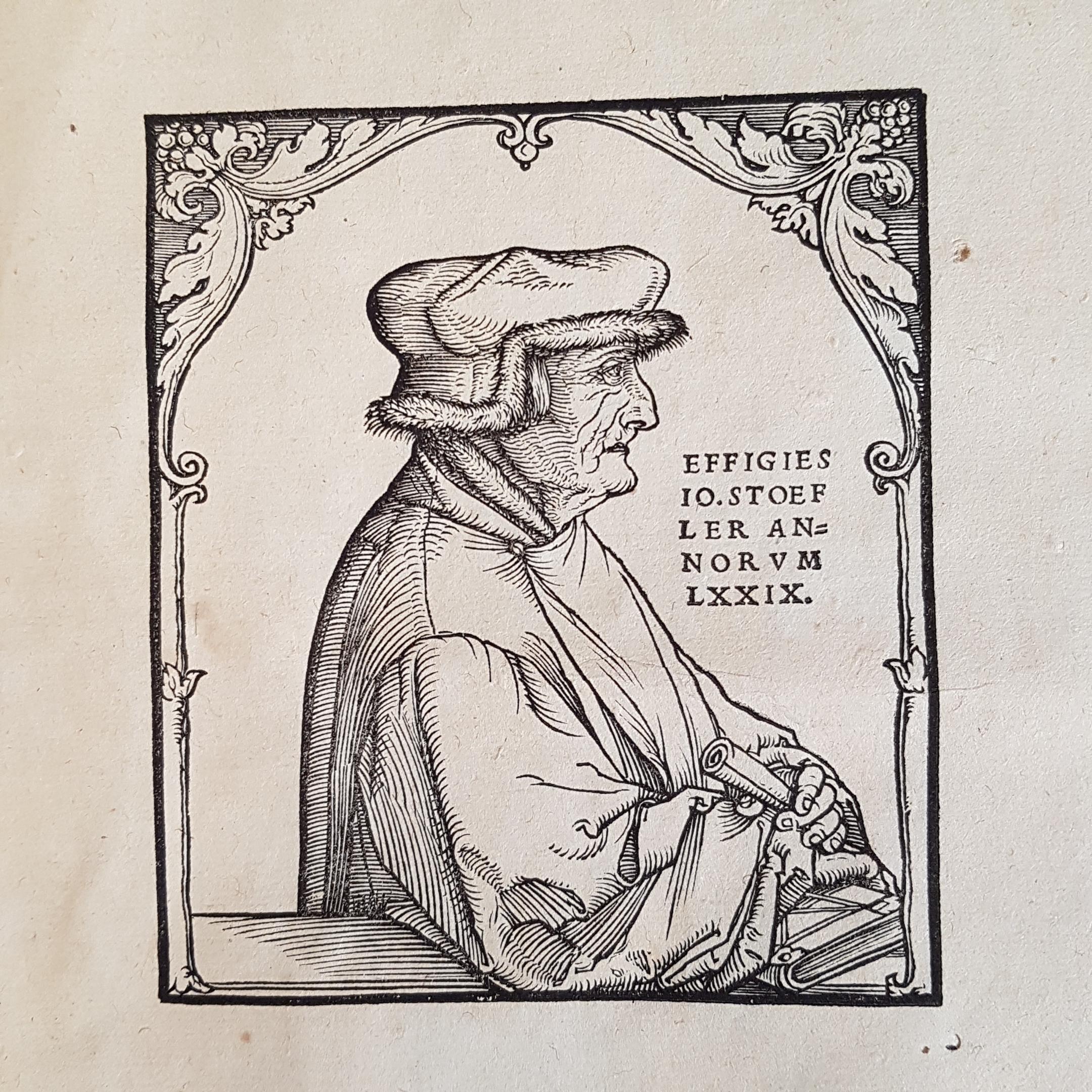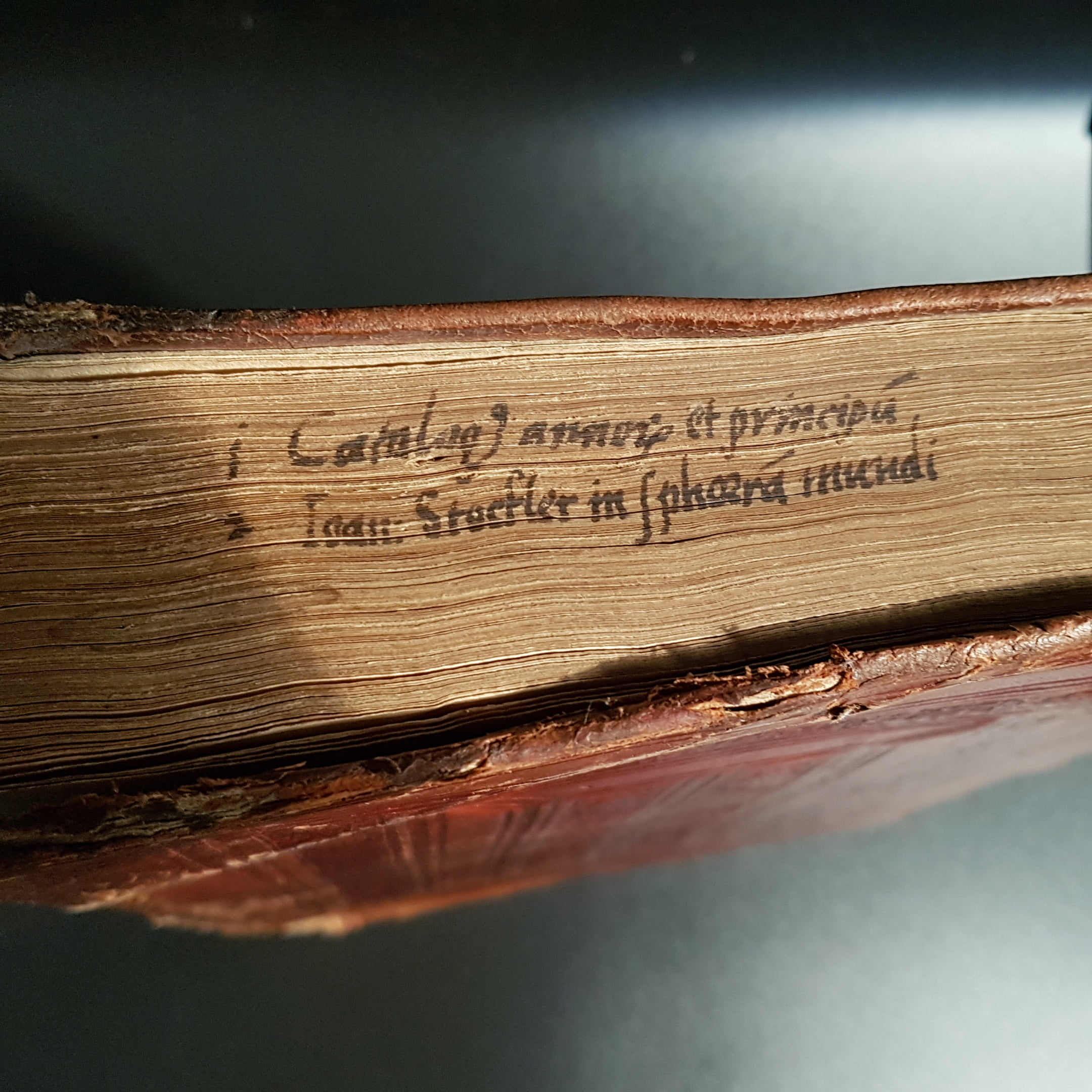RYD, Valerius [with] STÖFFLER, Johann
FINE CONTEMPORARY CALF
(1) Catalogus annorum et principum geminus ab homine condito. (2) n procli Diadochi…Sphaeram mundi…commentarius.
(1) Bern (2) Tubingen, (1) [Matthias Apiarius] (2)Ulrich I Morhart, (1) 1540 (2) 1534£9,500.00
FIRST EDITIONS. Folio. 2 works in 1, ff. (vi) 48 (viii) 135 [136] (i). Roman letter, little Italic. Woodcut printer’s device to t-p of first, woodcut author’s portrait to last of second, c.100 woodcut portraits of princes, genealogies, biblical and historical scenes to first, woodcut astrological schema to second, decorated initials and ornaments. Minor marginal thumbing to first t-p, scattered worm holes touching letter in a few places, slight browning with occasional faint marginal waterstaining to couple of gatherings of second. Very good copies in contemporary Swiss calf, traces of ties, double blind ruled to a panel design, outer border with roll of female allegorical figures and male and female figures in various poses, centre panel with rolls of male and female half figures in profile separated by ornamental designs, raised bands, spine double blind ruled in five compartments, large fleuron in blind to each, very slight rubbing and worming, small repair at foot of spine, loss to lower outer corner. Early casemark to front pastedown, ‘1302’ inked to t-p of first, titles inked to upper and lower fore-edges.
Handsomely bound, finely illustrated historico-astrological sammelband. Valerius Ryd (Valerius Anshelm, 1475-1546/7) was a Swiss historian and the official chronicler of the city of Bern—an appointment he received thanks to the fame achieved with his ‘Catalogus’. Written c.1510 and widely circulated in ms., it is a history of the world ‘ab homine condito’ (from the Creation) to the early C16, handsomely illustrated with biblical and historical scenes, heraldic shields, portraits of princes and genealogical trees in the style of the Nuremberg Chronicle. Ryd relied on the tradition of ‘universal historiography’ dating back to Eusebius’s ‘Chronicon’ (4th century), which rooted the history of the world in the genealogies of Genesis from Adam and Eve. The pivotal ancestor was Noah, whose three sons populated the world anew after the Flood—Japhet in Europe, Shem in Asia and Cham in Africa. Expanded by the Renaissance scholar Annius of Viterbo, this view of history embraced ancient and present civilisations within an immense genealogical network filling the gaps between Genesis and history with mythical figures like Hercules, the Amazons and Gomer, and it identified the passing of history with the (often artificial) linear progression of royal lines. The genealogies of the Four Kingdoms of Daniel—the empires of Babylon, Persia, Greece and Rome—are followed by those of European princes and the succession of the Popes. A beautifully crafted instance of the early modern chronicle tradition.
Johann Stöffler (1452-1531) was a German astrologer, astronomer and priest who taught at Tubingen—one of his students was Philip Melanchthon—and produced globes and clocks for notables including the Bishop of Konstanz. This sammelband features his most important, posthumous ‘Commentarius’ to Pseudo-Proclus’s ‘Sphaera’—a major text on cosmography for Renaissance astronomers attributed to a Neoplatonic Greek mathematician. However, ‘Commentarius’ presents Latin excerpts mostly from another ancient astronomical manual, Geminus’s ‘Isagoge’, discussing the structure of the earth, the trajectory of the sun, the zodiac and constellations. ‘Catalogus’ is renowned for its cartographically detailed references to the New World. For instance, in a paragraph on oceanic navigation Stöffler mentioned Vespucci’s discoveries and in another commenting on lands beyond the ‘terra cognita’ delineated by Ptolemy he mentioned new cartographic additions like ‘the western province of America near and partially under the Tropic of Capricorn’. He certainly consulted Martin Waldseemüller’s world map of 1507, the first to call the new continent ‘America’, and the only one to include, like his full passage, references to the Abbey of All Saints founded by Columbus as well as mention of smaller islands like St Marich and the Primeras.
I) BM STC Ger., p. 762; Brunet IV, 1473: ‘peu commun’; Graesse VI, 198. Not in Brunet. II) Sabin 91983; BM STC Ger., p. 716; Houzeau & Lancaster 2449; James Ford Bell 538. Not in Brunet, Alden or Caillet. C. van Duzer, ‘The Reluctant Cosmographer: Johannes Stöffler (1452–1531) and the Discovery of the New World’, Terrae Incognitae 49 (2017), 132-48.In stock


![RYD, Valerius [with] STÖFFLER, Johann](https://sokol.co.uk/wp-content/uploads/2019/05/20190404_163757.jpg)
![RYD, Valerius [with] STÖFFLER, Johann - Image 2](https://sokol.co.uk/wp-content/uploads/2019/05/20190404_164548.jpg)
![RYD, Valerius [with] STÖFFLER, Johann - Image 3](https://sokol.co.uk/wp-content/uploads/2019/05/20190404_164745.jpg)
![RYD, Valerius [with] STÖFFLER, Johann - Image 4](https://sokol.co.uk/wp-content/uploads/2019/05/20190404_165146.jpg)


![RYD, Valerius [with] STÖFFLER, Johann](https://sokol.co.uk/wp-content/uploads/2019/05/20190404_163757-324x487.jpg)